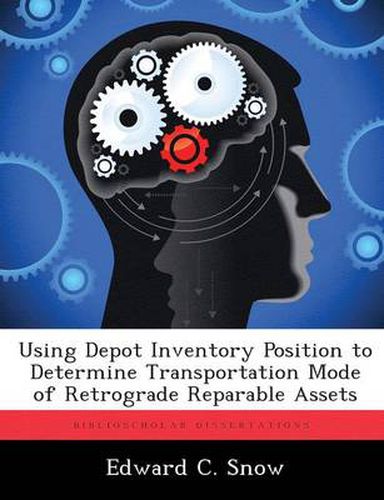Readings Newsletter
Become a Readings Member to make your shopping experience even easier.
Sign in or sign up for free!
You’re not far away from qualifying for FREE standard shipping within Australia
You’ve qualified for FREE standard shipping within Australia
The cart is loading…






This title is printed to order. This book may have been self-published. If so, we cannot guarantee the quality of the content. In the main most books will have gone through the editing process however some may not. We therefore suggest that you be aware of this before ordering this book. If in doubt check either the author or publisher’s details as we are unable to accept any returns unless they are faulty. Please contact us if you have any questions.
Air Force logistics policies direct the expedited evacuation of reparables and to the source of repair, in an effort to allow smaller inventories. Transportation Mode selection is based only on the asset itself. This focus works well when shipping assets out from the depot to a base. When a base ships an asset back to the depot however, the priority of the asset may not be the best way to select the transportation mode. The quantity of the assets at the depot may indicate that fast transportation is unnecessary. The depot may already have enough serviceable assets to meet demand or the number of unserviceable assets already waiting exceeds the depot’s repair capacity. If either of these inventory conditions exists, shipping an asset back to the depot using fast transportation is unnecessary and shipping the item via a slower and less costly mode could maintain the same service level. Rather than focus solely on the asset, the inventory of the depot should be involved in mode determination. This research evaluated current Air Force retrograde transportation mode selection policy.
$9.00 standard shipping within Australia
FREE standard shipping within Australia for orders over $100.00
Express & International shipping calculated at checkout
This title is printed to order. This book may have been self-published. If so, we cannot guarantee the quality of the content. In the main most books will have gone through the editing process however some may not. We therefore suggest that you be aware of this before ordering this book. If in doubt check either the author or publisher’s details as we are unable to accept any returns unless they are faulty. Please contact us if you have any questions.
Air Force logistics policies direct the expedited evacuation of reparables and to the source of repair, in an effort to allow smaller inventories. Transportation Mode selection is based only on the asset itself. This focus works well when shipping assets out from the depot to a base. When a base ships an asset back to the depot however, the priority of the asset may not be the best way to select the transportation mode. The quantity of the assets at the depot may indicate that fast transportation is unnecessary. The depot may already have enough serviceable assets to meet demand or the number of unserviceable assets already waiting exceeds the depot’s repair capacity. If either of these inventory conditions exists, shipping an asset back to the depot using fast transportation is unnecessary and shipping the item via a slower and less costly mode could maintain the same service level. Rather than focus solely on the asset, the inventory of the depot should be involved in mode determination. This research evaluated current Air Force retrograde transportation mode selection policy.